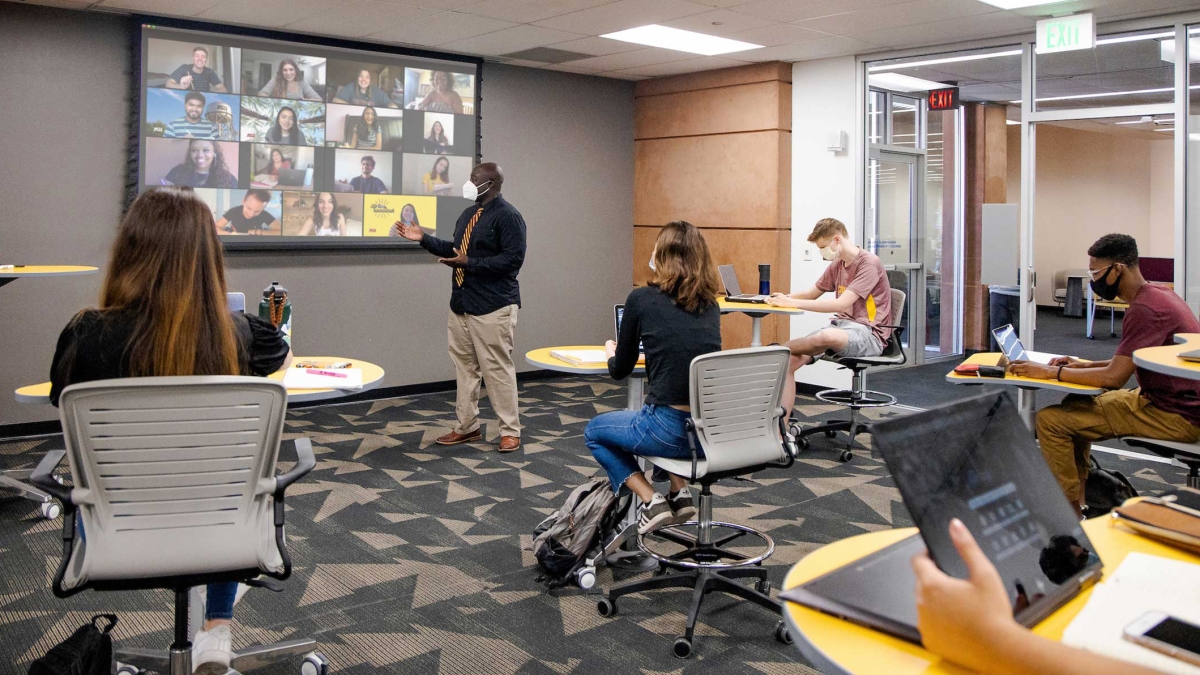ASU graduate engineering students to start fall term — everywhere

Classes conducted through ASU Sync offer live interaction with faculty and peers. The successful new learning model enables full student participation independent of their location. Photo courtesy of ASU
Demand is up for engineering graduate education at Arizona State University. Applications for fall 2020 admission to master’s and doctoral programs at the Ira A. Fulton Schools of Engineering have increased by more than 2,500 students compared to this time last year.
While uncertainty about enrollment in the context of COVID-19 has prompted some people to defer their start at ASU, most admitted graduate students are beginning this August to take advantage of flexible attendance options and added professional incentives.
One key element is the distinction between starting classes and arriving on campus. These two events traditionally happen at the same time, but ASU’s technology and content design innovations are disrupting the conventional link between class location and participation. Fulton Schools students can now begin live courses remotely and then join their cohort in person whenever circumstances permit their arrival in Arizona.
This means students from locales as far-flung as Chennai, India; Chengdu, China; and Chicago can enroll in their programs and begin coursework in August but delay travel to ASU until September, October or even early November. If arrival on campus is further delayed, the Fulton Schools will support continued participation in the manner that best suits each enrolled student.
“We know graduate students want a full experience, so we have developed course options that are both flexible and immersive,” said Jim Collofello, vice dean of academic and student affairs for the Fulton Schools. “These are live classes that happen in a format we call ASU Sync. Instead of walking to a building across campus, students are connecting via Zoom. They are engaging with faculty on screen, asking questions and getting answers. They are also building relationships with their peers.”
ASU began applying this live-hosted digital learning platform on a wide scale during the spring, when social distancing protocols were implemented to protect students, faculty and staff amid the pandemic. The results have been so successful that even graduate students who are physically present on campus this fall will go into classrooms for only a portion of their course sessions. Through ASU Sync, they will attend half or more of their class meetings digitally, alongside peers from across the country and around the world.
“Knowing these are real-time, interactive courses and not conventional online classes has swayed a lot of people,” said Anca Castillo, associate director of engineering student recruitment at ASU. “They are ready to start their graduate education when they realize the student experience is now virtually the same, independent of geographic location.”
For example, the Fulton Schools scheduled more than 40 fall classes at times convenient for people who will be attending from India and China. Castillo says these sessions will take place either early in the morning or during the evening for those students, which is far more practical than trying to join live classes via Zoom in the middle of the night.
Another incentive for graduate students beginning this fall relates to the Six Sigma process improvement and quality assurance methodology so highly regarded in the engineering world. Castillo says up to half of all current engineering job postings identify Six Sigma certification as a desired qualification.
“So, we are encouraging students to enroll this fall and take advantage of the Six Sigma Green Belt certification course offered through our Global Outreach and Extended Education office,” Castillo said. She also notes that this training is available to incoming students for just $99 rather than the standard $1,295 cost.
“It’s a meaningful opportunity for those who are joining us in August,” she said. “In fact, we already have more than 200 students who are enrolled and registered for the course. Some have shared that Six Sigma and the pre-professional support it represents was a determining factor for their fall enrollment.”
Finding a new job in the context of COVID-19 is a significant challenge across America, so the Fulton Schools created an Optional Practical Training, or OPT, experience to employ students on a volunteer basis. While unpaid, these opportunities enable graduates to apply their engineering skills by working on industry-led projects for a range of companies and nonprofits while they seek paid positions.
“For international students who complete their studies at ASU, OPT is an aspect of the visa that enables them to work in the U.S.,” Collofello said. “Since finding a position can be difficult right now, we want to help students get both industry experience and additional time to find their desired role.”
Collofello says accepted graduate students can be confident they will be fully supported in the process of starting their program at the Fulton Schools. He says the flexible course options and added incentives represent significant reasons to begin this fall.
The Fulton Schools enrollment options webpage explains how admitted engineering students are joining their graduate programs this August in ways that best meet their needs.
More Science and technology

ASU-led space telescope is ready to fly
The Star Planet Activity Research CubeSat, or SPARCS, a small space telescope that will monitor the flares and sunspot activity…

ASU at the heart of the state's revitalized microelectronics industry
A stronger local economy, more reliable technology, and a future where our computers and devices do the impossible: that’s the…

Breakthrough copper alloy achieves unprecedented high-temperature performance
A team of researchers from Arizona State University, the U.S. Army Research Laboratory, Lehigh University and Louisiana State…

